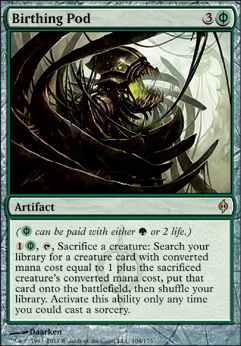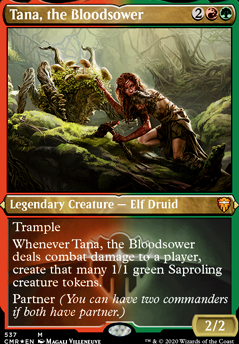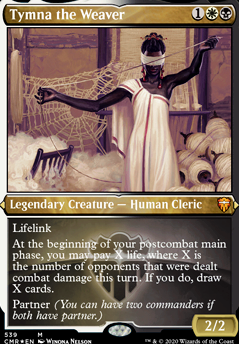Blood Pod to Stax out my playgroup.
Gameplan
The general gameplan of the deck is to play out hate pieces which will slow down the fastest decks first. For example, if you think the storm player at your pod is the fastest one there, prioritize a tax effect, or rule of law effect. If the fastest deck is an artifact deck, look for stony silence or null rod. Once we've slowed them down, we can play out our commanders and start to generate tokens and draw cards. Prioritize hitting ad naus players first, but hopefully you can hit every opponent every combat (for maximum Tymna draws).
Now, there are combo lines in this deck. Again, I want to stress that these should very rarely be plan A. Most of the time, you'll hold everyone down and then stumble into the combo once their resources have been exhausted.
Birthing Pod: If you have both of your commanders out, you pod Tymna (or a 3 drop) for Felidar Guardian and target Birthing Pod with Guardian's ETB effect. Once pod is flickered (and untapped) we pod Tana (or another 4 drop (not guardian)) into Kiki-Jiki, Mirror Breaker who can make infinite Guardian tokens (copy guardian, flicker Kiki, repeat)
Otherwise, pod a 3 drop into felidar, flickering pod. Pod guardian into karmic guide bring back guardian and flicker pod. Pod guardian to get Kiki. Copy Karmic to bring back guardian and then make infinite cats.
The Buried Alive combo requires buried alive and a reanimate spell. Cast buried alive, putting Kiki-Jiki, Mirror Breaker, Karmic Guide, and Village Bell-Ringer into the bin. (Guardian can replace bell ringer, but its easier to pod out guardian than bell ringer, so I like to prioritize binning bell ringer). Reanimate Karmic guide, which reanimates Kiki. Kiki copies Karmic guide. The copy reanimates Bell ringer, who untaps Kiki and you're off to the races.
Survival of the Fittest works similarly to the Buried alive combo. Tutor up Kiki by ditching a random creature. Then bin Kiki, getting Bell Ringer. Then discard Bell ringer to get Karmic guide. Cast karmic guide and proceed with the buried alive loop.
Yisan, the Wanderer Bard is pretty simple. Get a one drop (I like Serra Ascendant), then a 2 drop (usually Bloom Tender) at the end of the turn before yours. Then you untap, tap bloom tender (hopefully for 3 or 4 mana), use that mana to activate Yisan, go get bell ringer, who untaps Yisan and Tender. Use tender to activate Yisan to 4, getting Guardian who bounces Bell Ringer. This will untap Yisan and Tender, and you can activate to 5 to get Kiki and make infinite humans or cats.
three different factors:
Opening Hand
Other Decks at The Table
Position at the Table.
Opening Hand
Before we talk about how to start each game, here's a short bit on mulligan decisions. Generally speaking, our ideal hand will look similar to this: 2-3 lands, 1-2 piece of ramp, 2-3 pieces of interaction/stax. While Mulligan decisions definitely go hand in hand with our gameplan, there are certain hand configurations that we really don't want to see:
Too many lands: This one applies to pretty much every cEDH deck out there. Even when going for a long game, you don't want to keep a hand that is too heavy on lands and too light on gas.
0-1 lands: There are very, very few situations where keeping a no-lander is worth it, so this should almost always be shipped back. One land is keepable if your hand has a decent balance of ramp and draw.
Very slow hands: If our hand is several pieces of interaction, a tiny bit of ramp, and no real way to slow down the board, it should go back. Especially in games against combo decks, we want to have the ability to live past turn 4, so just keeping ramp and a 6 drop isn't gonna work most of the time.
All ramp hands: If we've got a hand where we can have like 6-7 mana by turn 3, but without any real payoff, we should mulligan. Although this deck plays a lot of mana dorks, it will quickly look weak when there's no payoff for that Mana.
All-in hands: These can be kept against the certain decks, but most times, you should expect early interaction from your opponents. If our hand relies on one key piece too much, we can fall very far behind if that particular piece gets interacted with.
After we've decided to keep our opening hand, the main criterion of evaluation should be the hand's stax suite.We don't need a way to prevent everyone from playing spells, just enough to slow down the fast decks until we can get our card advantage engine online. The main questions you should try to answer when looking at your hand is:
How quickly can we establish a strong board presence?
How do we get our engine/stax pieces online?
A strong board presence can mean a lot of things in this deck, but it basically boils down to having access to more Mana than our opponents. This can be achieved in a variety of ways: Having a lot of cheap Mana dorks, getting down an early hate piece, or even shutting off our opponents' access to Mana through cards like Contamination, Magus of the Moon, or Choke
After establishing our board, we basically just want to get out our two generals, and start getting tokens and drawing cards. This will allow us to see more hate pieces, and more creatures to add to our board. Eventually this snowball will get too big for our opponents to handle.
Unlike many other cEDH decks, as long as we can provide an early lock we're pretty much set. Our commanders will generate both fodder to throw at people, and card draw. So we will easily be able to break parity and run away with the game.
To simplify everything, all you really need to have a good opening hand is relevant stax cards, and some sort of mana acceleration. Beyond those things, our commanders fill in the gaps.
Matchups
The second big factor when it comes to deciding on our initial gameplan is matchups. After taking a good look around the table, we should try to identify our opponents' decks and consider their possible gameplans. When doing this, most cEDH decks can usually be classified by two categories: speed and interactivity. Speed, in this case, means how early in the game a deck can usually threaten to win. Interactivity not only correlates with the amount of interaction a deck runs, but also it's willingness to use this interaction to prolong the game.
COMBO KILL
Combo Kill Show
Splinter Twin + Goblin Sharpshooter + any x/1:
Twin on Sharpshooter #1.
Tap #1 to create #2.
Tap #2 to kill a dork. #1 and #2 untap.
Loop:
Tap #1 to create #3.
Tap #2 to damage face.
Tap #3 to kill itself. #1 and #2 untap.
Splinter Twin + Village Bell-Ringer
Kiki-Jiki + Village Bell-Ringer / Felidar Guardian
Buried Alive -> Kiki-Jiki + Felidar Guardian + Karmic Guide -> Animation Effect -> Karmic Guide -> Guardian bounces Guide -> Kiki-Jiki
Survival of the Fittest + 3green + 2white + 3mana -> discard each to find the next -> Kiki-Jiki -> Felidar Guardian -> Karmic Guide -> Play Karmic Guide -> etc
Survival of the Fittest + animation effect + 4green -> Kiki-Jiki -> Felidar Guardian -> Karmic Guide -> discard Karmic Guide -> animate Karmic Guide -> etc
Yisan already in play for a turn, going into your turn + 6 mana -> 1 for Quirion -> 2 for Bloom Tender -> let their turn and let yourself untap -> 3 for Village Bell-Ringer (also untaps the Bloom Tender) -> 4 for Felidar Guardian -> 5 for Kikijiki
Birthing Pod + 3drop + 4drop + 2mana -> pod 3 into Felidar Guardian -> Flicker Pod -> pod 4 into Kiki-Jiki
Birthing Pod + 3drop + 3mana -> pod 3 into Felidar Guardian -> Flicker Pod -> pod Felidar Guardian into Karmic Guide -> reanimate Felidar Guardian -> Flicker Pod -> pod Felidar Guardian into Kiki-Jiki -> Copy Karmic -> reanimate Felidar Guardian -> etc
Yisan can be used both to get hate pieces at instant speed as well as to assemble the Kiki-combo. By including Quirion Ranger, the Yisan lines get significantly more varied and complicated; using it to double up on a number like 2 or 3 can be incredibly strong and find the correct hate pieces that can seal up the game before using him at 4 and 5 for combo pieces. The main win-line with Yisan is to play him out, untap with him, and then before you untap a 2nd time, use 6 mana to get Quirion and a 2drop mana dork / hate piece, and after untapping use him to get Bell-Ringer, who will untap him, Felidar who will bounce the Bell-Ringer and finally Kiki; if your 2-drop dork produces 2-3 mana this was all “free”.



